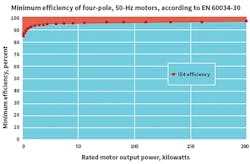Premium Power Drive Systems
Increasingly in industrial and commercial HVAC applications, electric motors are being combined with power converters to form premium power drive systems (PPDS). When used in variable-flow applications, PPDS can deliver savings unmatched by mechanical speed/flow-control systems.
Today, motors in the 1-to-500-hp range achieve efficiencies in the mid-to-high-90-percent range. This level of performance has led manufacturers to search for methods other than reducing electrical losses to increase motor efficiency. Engineers long have known that adding a power converter, or variable-frequency drive (VFD), for speed and load management will deliver energy (kilowatt-hour) savings much greater than those delivered by a motor alone.
The NEMA (National Electrical Manufacturers Association) Premium label was introduced in 2001 to identify highly energy-efficient motors. NEMA Premium has been endorsed or adopted by end users, original equipment manufacturers (OEMs), the International Electrotechnical Commission, IEEE, and power utilities. NEMA Premium products have become the standard for PPDS.
Regulators, power utilities, manufacturers, trade associations, and others are coming together to quantify the benefits of managing power with PPDS. This is taking place globally, with a switch from what is referred to as Stage One (component efficiency) to Stage Two systems, or extended-product energy savings. In other words, we have moved into an era in which recognition of the affinity laws has taken a leading role. Historically, regulators and power programs viewed Stage Two as too complex, requiring significant engineering and application resources to quantify and verify energy savings. As a result, support and funding for Stage Two applications was limited.
What’s Changed?
Utilities, end users, and OEMs are realizing issues of complexity can be overcome and greater savings achieved with a hybrid PPDS approach. The goal is to move the PPDS from a resource-intense custom application to more of a simple motor-component one. Trade organizations representing pumps, compressors, fans, motors, and power converters have joined utilities and energy advocacy organizations in this effort. The Department of Energy (DOE) is conducting rule-making procedures for all of these products. As it releases individual product rules, the DOE is expected to include test procedures and metrics that quantify PPDS energy savings and set baseline performance levels. The trade associations working in conjunction with utility-program managers will evaluate savings opportunities and jointly develop product labeling to move PPDS products from needing costly evaluation, measurement, and verification to a middle ground where power utilities can establish broadly applicable incentives based on established DOE methods and metrics.
The extended-product-labeling scheme will draw on load-specific federal extended-product regulations to substantiate premium pump/fan or compressor labels meeting power-utility incentive-program requirements. These programs are expected to incentivize extended products that include all three components: motor, power converter, and driven load. A NEMA Premium PPDS including motor and control can supply a fan, pump, or compressor system with the drive components to deliver energy savings many times those of a more efficient motor or driven load alone.
The goal is to satisfy public-service-commission needs for energy-savings data reaching the level of acceptance seen with the NEMA Premium motor label. NEMA and other trade associations will test extended-product samples using DOE standards to verify accuracy and repeatability. Once the DOE standards are issued, trade associations will work with utilities and program managers to establish premium performance levels and identify products compliant with the labeled PPDS.
Conclusion
Recognition of the PPDS’s ability to save energy, along with acceptance of the performance label, shifts market perspective from efficiency to energy savings, and that is a real game-changer.
Rob Boteler is government-relations consultant for Nidec Motor Corp. and chairman of the NEMA (National Electrical Manufacturers Association) MG 1 Energy Committee.
Did you find this article useful? Send comments and suggestions to Executive Editor Scott Arnold at [email protected].


